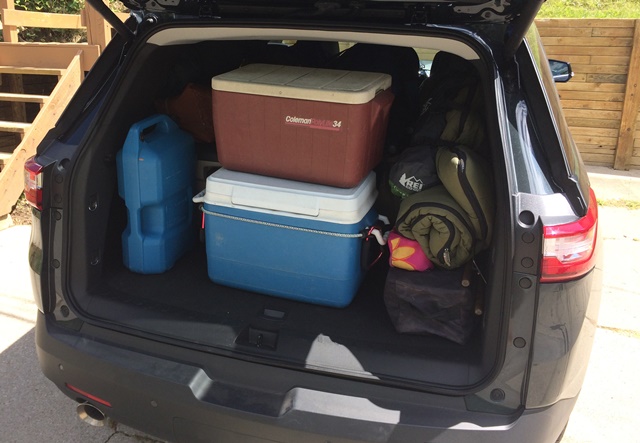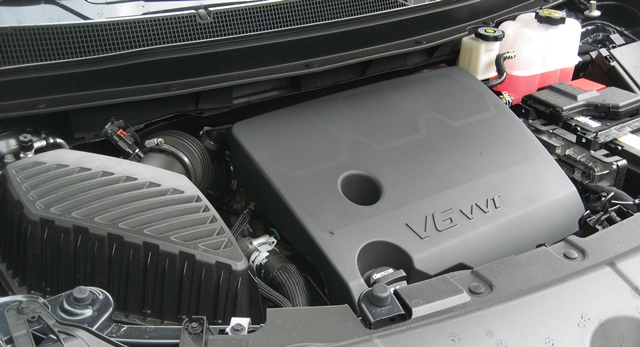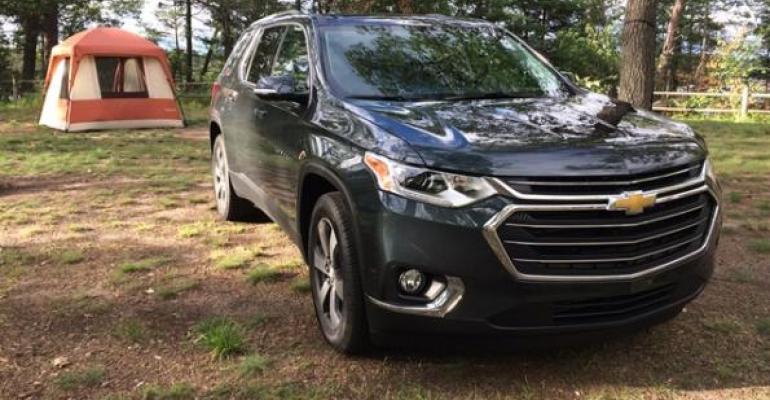MIO, MI – Call it the “call of the wild.”
We could have taken the redesigned ’18 Chevrolet Traverse on a civilized, mostly freeway drive to a swanky hotel in northern Michigan, but our plans pointed us in a much more rustic direction.
Instead of packing a suitcase for a luxurious spa- and resort-style stay, we loaded General Motors’ latest people-and-cargo hauler with all the necessary gear for a camping and river floating trip in the great outdoors.
All of this is apropos, considering the new Traverse eschews its rounded, around-town errand-runner CUV styling for a much boxier design that shares macho truck-like cues with its fullsize Tahoe and Suburban SUV siblings.
Thanks to the squared-off styling and attention to detail inside, interior volume is up 6.5 cu.-ft. (184 L) to 157.3 cu.-ft. (4,454 L), with a few extra inches going to second-row legroom, but the majority boosting cargo space. Chevy says total cargo room is best-in-class at 98.5 cu.-ft. (2,789 L), up 6.7 cu.-ft. (190 L) with second and third rows folded; 58.1 cu.-ft. (1,645 L), up 5.5 cu.-ft. (156 L) behind the second row; and 23 cu.-ft. (651 L) behind the third row.
In addition, the hidden storage beneath the cargo area floor grows from 1.1 cu.-ft. (31 L) to 3.2 cu.-ft. (91 L), giving the formerly barely usable space real value for tucking away bulky items like life jackets or soft travel bags.

We flattened the third row and the Traverse absorbed a load that included tents, sleeping bags and pads, camp kitchen, coolers, a pop-up shelter, clothes bags and backpacks, along with enough inflatables to support half a dozen river floaters.
The Traverse 3LT powering our woodsy adventure features the carryover 3.6L V-6, upgraded with improved breathing good for an extra 29 hp, but the real gain is in power-to-weight ratio. The front-drive Traverse sheds 351 lbs. (159 kg) compared with the previous generation, now tipping the scales at 4,362 lbs. (1,978 kg).
That means the 310-hp, 266-lb.-ft, (361-Nm) 3.6L now pushes nearly 100 lbs. (45 kg) less per liter and that translates into noticeably improved power to pass and ample hauling and towing capacity without any increase in torque. Towing tops out at 5,000 lbs. (2,268 kg).
EPA-rated fuel economy is 18/27 mpg city/highway (13.0-8.7 L/100 km), a 1 mpg (0.44 km/L) improvement in the city and 3 mpg (1.3 km/L) highway. AWD cuts efficiency by 1 mpg on each measure.
New for ’18 is the sporty blacked-out RS trim featuring a turbocharged, direct-injected 2.0L Ecotec I-4 producing 255 hp and 295 lb.-ft. (400 Nm) of torque. Both the V-6 and I-4 are mated to 9-speed automatic transmissions and all models have engine stop/start. All-wheel drive is optional.
At the top end of the range, Chevy now offers the High Country trim fitted with all the bells and whistles, leather and suede interior, power-folding third row, hands-free power liftgate and standard twin-clutch AWD.
During our 445-mile (716-km) round trip to the scenic Au Sable River valley we cover the gamut, from expressway to back roads and back again, hauling both cargo and passengers, and the Traverse never lacks for power.

The new 9-speed automatic transmission reacts quickly in all driving situations, downshifting rapidly to provide passing power. The vehicle chassis feels much lighter and responsive compared with its predecessor, with good body control and solid braking.
The new electric-assist, variable effort steering (replacing hydraulic assist) is predictable at most speeds but seems to lag in low-speed maneuvers. We could use a little less tire noise, or additional insulation to help the active-noise cancellation, to keep the cabin a bit quieter.
While traveling and at the campsite, the vehicle’s 4G LTE Wi-Fi provides a connection to the outside world and is capable of supporting up to seven devices. Having seen firsthand how this feature allows everyone on a trip to work or play using their own phones, laptops or tablets, we’re sold.
We also note the Traverse’s six powered USB ports, two for each row, allowing everyone on board to keep their electronics charged and running. In addition, a handy 120V outlet is available to power an air pump needed to inflate mattresses and our myriad river rafts and tubes as needed.
Although the Traverse often is cross-shopped against the Ford Explorer, Jeep Grand Cherokee and Toyota Highlander, all of which outsell it by a wide margin, WardsAuto places the vehicle in the Large CUV segment where it leads all competitors including its stablemates the Buick Enclave and GMC Acadia, Ford Flex, Mazda CX-9, Nissan Pathfinder and the newly introduced Volkswagen Atlas.
GM sold 116,701 Traverses in 2016, just off the peak of 119,945 the previous year, WardsAuto data shows. Sales were off 6.0% through July this year on 65,584 deliveries in a segment that is down 11.1%.
Our 3LT tester carried a list price of $44,185, about midrange for the Traverse. Base pricing starts at $30,875 and tops out at $52,995 (all prices include $945 destination charge).
[email protected] @bobgritzinger
'18 Chevrolet Traverse 3LT Specifications
| Vehicle type | 7-passenger, 5-door CUV |
| Engine | 3.6L direct-injected all-aluminum DOHC V-6 |
| Power (SAE net) | 310 hp @ 6,800 rpm |
| Torque | 266 lb.-ft. (361 Nm) @ 2,800 rpm |
| Bore x stroke (mm) | 94.0 x 85.6 |
| Compression ratio | 11.5:1 |
| Transmission | 9-speed automatic |
| Wheelbase | 120.9 ins. (3,071 mm) |
| Overall length | 204.3 ins. (5,189 mm) |
| Overall width | 78.6 ins. (1,996 mm) |
| Overall height | 70.7 ins. (1,795 mm) |
| Curb weight | 4,362 lbs. (1,978 kg) |
| Base price | $41,150 (not including $945 destination and handling charge) |
| Fuel economy | 18/27/21 mpg (13.0/8.7/11.2 L/100 km) city/highway/combined |
| Competition | Ford Explorer, Mazda CX-9, Nissan Pathfinder |
| Pros | Cons |
|---|---|
| Adds 9-speed, stop/start technology | City mpg still sub-20 |
| Best-in-class cargo room | Third row remains a squeeze |
| Huge weight reduction | Needs more tire-noise insulation |





